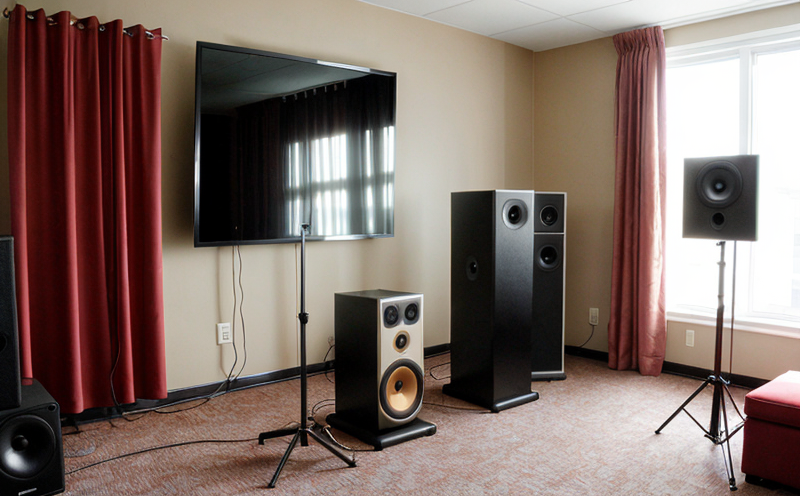ANSI/ASA S3.4 Subjective Loudness Balance Testing
The ANSI/ASA S3.4 standard defines subjective loudness balance testing as a method to evaluate the perceived loudness of audio signals in accordance with human auditory perception. This service is crucial for ensuring that sound outputs from various devices and systems are balanced in a way that aligns with human hearing sensitivity.
Subjective loudness balance testing involves listening tests conducted by trained listeners who assess how well different frequencies and levels within an audio signal are perceived as balanced. The standard specifies the procedures, criteria, and equipment necessary for performing these tests to ensure consistency and reliability across different applications.
This type of testing is particularly important in sectors like consumer electronics, automotive engineering, and entertainment technology where sound quality can significantly impact user experience and product performance. For instance, in consumer electronics, ensuring that a television or speaker system delivers balanced loudness levels helps maintain the intended audio experience for users regardless of volume settings.
The ANSI/ASA S3.4 standard is widely recognized and adopted by industries worldwide due to its rigorous methodology and focus on human perception. By adhering to this standard during product development, manufacturers can guarantee that their products meet high-quality sound reproduction expectations set forth by industry professionals and end-users alike.
Key aspects of ANSI/ASA S3.4 Subjective Loudness Balance Testing include:
- Training and certification of listeners
- Use of standardized test signals
- Involvement of multiple listeners for consistency checks
- Analyzing loudness levels across various frequency bands
The testing process typically involves playing audio clips through different speakers or headphones while listeners rate the perceived balance on a predefined scale. The results are then analyzed statistically to ensure that deviations from expected values fall within acceptable tolerances.
By leveraging ANSI/ASA S3.4 Subjective Loudness Balance Testing, organizations can enhance their products' acoustic performance, leading to improved satisfaction among customers and better market positioning.
Scope and Methodology
The scope of the ANSI/ASA S3.4 Subjective Loudness Balance Testing encompasses evaluating audio signals for perceived loudness balance according to human auditory perception standards. This service applies primarily to consumer electronics, automotive engineering, and entertainment technology sectors.
In terms of methodology, the testing follows a structured approach outlined in the standard. It begins with selecting appropriate test signals that cover various frequency bands relevant to human hearing. Next, trained listeners evaluate these signals using standardized procedures. Multiple rounds of listening tests are conducted to ensure consistency and reliability of results.
The methodology also includes detailed instructions on how to analyze data collected from listener evaluations. This involves calculating statistical measures such as mean, standard deviation, and confidence intervals for perceived loudness balance across different frequency bands.
For consumer electronics applications, the focus is on ensuring that audio outputs are balanced so they sound natural and pleasing at all volume levels without distortion or excessive emphasis on any particular frequency range. In automotive engineering, this translates to creating optimal listening environments within vehicles where passengers can enjoy high-quality sound playback regardless of driving conditions.
In entertainment technology, the goal is to deliver consistent loudness performance across various types of content like music, movies, and podcasts so users have an enjoyable experience no matter what they are watching or listening to.
Benefits
- Ensures high-quality sound reproduction that aligns with human auditory perception
- Improves user satisfaction by delivering balanced audio experiences across all volume levels
- Aids in compliance with industry standards and regulations related to audio quality
- Enhances brand reputation through consistent product performance
- Promotes innovation by allowing manufacturers to explore new sound design possibilities
- Facilitates easier comparison between different products within a category
- Supports research and development efforts aimed at improving audio technology
- Aids in identifying areas for improvement in existing product designs
Use Cases and Application Examples
| Application | Description |
|---|---|
| Consumer Electronics | Evaluating the loudness balance of televisions, speakers, and headphones to ensure a natural and enjoyable listening experience. |
| Automotive Engineering | Ensuring that vehicle interiors provide optimal sound environments for passengers regardless of driving conditions. |
| Entertainment Technology | Creating consistent loudness performance across various types of content to enhance user satisfaction. |
| Audio Post-Production Studios | Assuring that final audio mixes meet industry standards for perceived loudness balance. |
| HVAC Systems Design | Determining the impact of sound generated by HVAC systems on building occupants' comfort and well-being. |
| Sporting Event Organizers | Evaluating ambient sound levels at sports venues to ensure they do not interfere with athletes' performance or spectators' enjoyment. |
| Public Address Systems | Ensuring that announcements and background music are heard clearly by all audience members without distortion. |





